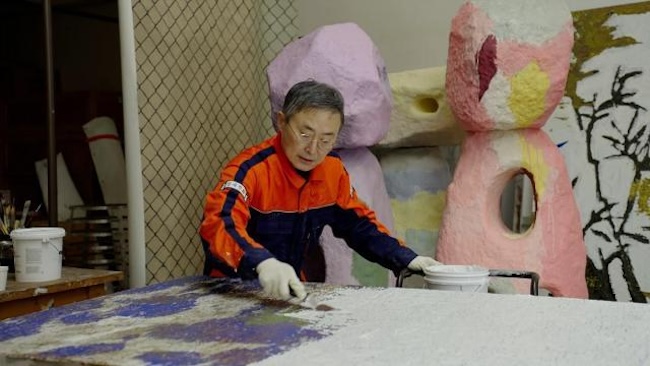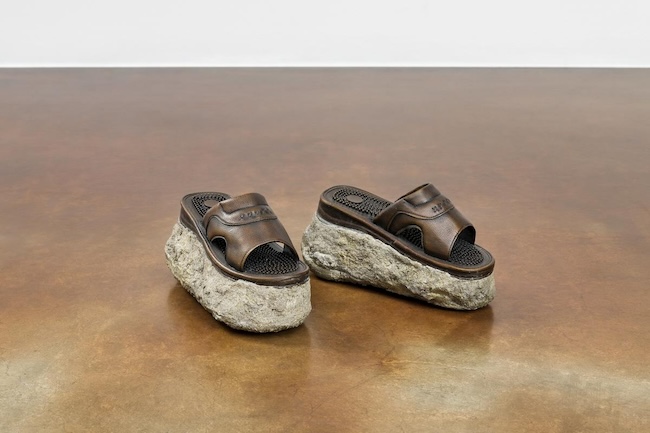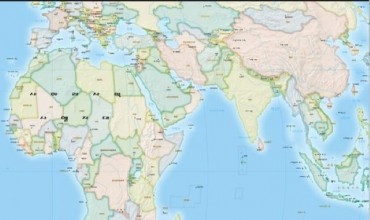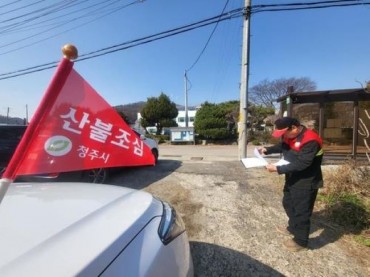
This undated photo, provided by Kukje Gallery in Seoul on Feb. 5, 2024, shows South Korean artist Gimhongsok. (Image courtesy of Yonhap)
SEOUL, Feb. 5 (Korea Bizwire) — A cat stands against a dark gray wall wearing the mask of a joker. Or is it the joker dressing in a cat costume? Next to the weird resin sculpture lies a pair of bronze slippers on top of thick stone platforms, proclaiming to be a pair of high-heeled shoes.
Encompassing a wide spectrum of materials and techniques, artist Gimhongsok’s artworks begin with long-held questions, for which the artist has been seeking answers for more than two decades: What does art do? What makes a work art?
“While it is hard to define art, I believe I have a duty, as an artist, to try to break down the customs, systems and traditions that are rarely questioned,” the artist said during an interview with Yonhap News Agency at Kukje Gallery in Seoul on Monday.
“I want to show that things do not always have to be the way they are now. I want to create a crack in people’s long-held perceptions,” he said.
His solo exhibition, “Normal Order Aimed at Failure,” a title riddled with irony, opened last week at the gallery, displaying his latest sculptures and paintings that challenge existing norms and expectations.
On the global art scene, artworks that do not fit into the categories defined by the West are easily brushed off as being abnormal, he said, adding what he aspires to do is to confront the Western-centered art system with satirical and witty artworks and performances.

“A Pair of High Heels” is shown in this photo provided by Kukje Gallery in Seoul on Feb. 5, 2024. (Image courtesy of Yonhap)
“If I do it right, people would call it normal art. So I intentionally made it a flop to defy fitting into what is defined as being normal by the Western art standards,” he said.
Shy and curious, he had a lot of questions about his surroundings from a young age, he said. He tried to seek answers by reading books and talking to his seniors and friends. A sculpture major at Seoul National University, he went to Germany and studied at the prestigious Kunstakademie Duesseldorf in the 1990s.
A watershed moment came for him when one of his German professors advised him to focus on artworks that could show unique Korean traits, sensibility and identity.
After much soul-searching, he concluded such a work would be marginalized after all under the dichotomy of the West versus non-West art. Instead, he began to explore the role and utility of art in general.

Artist Gimhongsok’s “An Actual Villain” is shown in this photo at Kukje Gallery in Seoul on Feb. 5, 2024. (Image courtesy of Yonhap)
Paying attention to the peripheries, like wood crates, cardboard boxes, left-over wrapping and carpet at the exhibition hall, the artist turned them into the subject matters of his artworks. One such work includes a large bronze Teddy bear, designed to look as if it is made from garbage bags.
“I believe marginal things can take center stage. I want to make it happen in my art,” he said, stressing that art should serve as a means of deconstructing popular perceptions of the world. “My artworks are not meant to last forever. They will fully serve their purpose if they can deliver the message.”
The exhibition runs through March 3.
(Yonhap)






